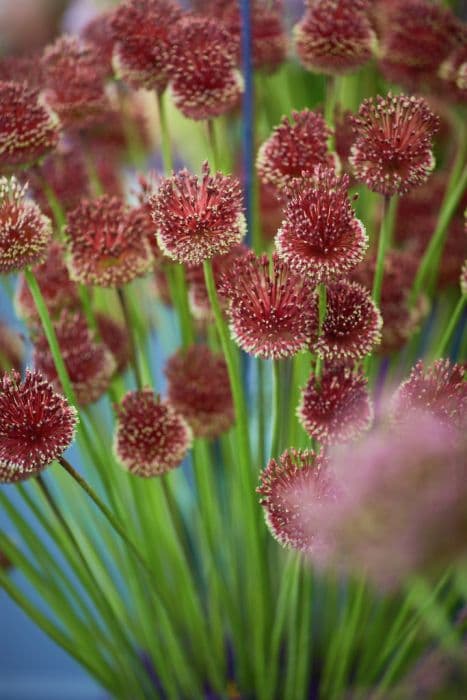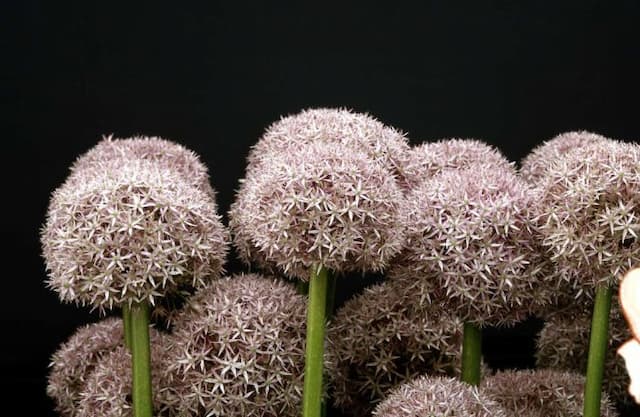Allium 'Metallic Shine' Allium 'Metallic Shine'

ABOUT
'Metallic Shine' is a bulbous perennial to around 70cm high with strap-shaped leaves. Almost spherical flowerheads comprising purple, star-shaped flowers with a silvery, metallic sheen are borne in late spring to early summer
About this plant
 Names
NamesFamily
Amaryllidaceae
Synonyms
Ornamental Onion, Flowering Onion
Common names
Allium 'Metallic Shine'
 Characteristics
CharacteristicsLife cycle
Perennials
Foliage type
Deciduous
Color of leaves
Varies
Flower color
Purple
Height
2-3 feet (60-90 cm)
Spread
1 foot (30 cm)
Plant type
Bulb
Hardiness zones
4-8
Native area
Asia
Benefits
 General Benefits
General Benefits- Ornamental Appeal: Produces attractive purple flowers that add aesthetic value to gardens.
- Drought Tolerance: Once established, it has a good tolerance for drought conditions, reducing the need for frequent watering.
- Pest Resistant: Naturally resistant to pests, limiting the need for chemical pesticides.
- Low Maintenance: Requires minimal care beyond basic watering and occasional fertilization.
- Adaptable: Can thrive in a range of soil types, from sandy to clay.
- Attracts Pollinators: Flowers are known to attract bees, butterflies, and other beneficial pollinators.
- Compact Growth: Suitable for small spaces and borders due to its compact growth habit.
- Seasonal Interest: Provides seasonal interest with its blooms in late spring to early summer.
- Deer Resistant: Less likely to be damaged by deer compared to other garden plants.
 Medical Properties
Medical PropertiesThis plant is not used for medical purposes.
 Air-purifying Qualities
Air-purifying QualitiesThis plant is not specifically known for air purifying qualities.
 Other Uses
Other Uses- Decorative dry arrangements: The striking seed heads of Allium 'Metallic Shine' can be used in dry floral arrangements to add texture and visual interest.
- Natural dye: The skins of the bulbs can be used to produce a natural dye for fabrics or yarns.
- Photography: Its unique appearance makes it a popular subject for garden photographers and botanical artists.
- Garden design: It can be used as a structural plant in garden design, providing height and color contrast among lower-growing plants.
- Educational tool: Allium 'Metallic Shine' can be used in schools or educational programs to teach about plant lifecycle and pollinator attraction.
- Crafts: Dried flower heads can be incorporated into handmade wreaths or other craft projects.
- Fish ponds: When planted nearby, they can help to repel insects that might otherwise bother pond fish.
- Erosion control: Its root system can help stabilize soil and reduce erosion on slopes in a garden setting.
- Companion planting: It is sometimes used in companion planting to help deter pests from more susceptible vegetables and fruits.
- Culinary garnish: Although not a common use, the flowers can occasionally be used as an edible garnish to add a splash of color to salads and dishes.
Interesting Facts
 Feng Shui
Feng ShuiThe Allium, commonly known as ornamental onion, is not specifically mentioned in classical Feng Shui practice. However, as with other plants, it can bring a sense of balance and positive energy if placed in the right area of a home or garden, depending on its color and the Five Elements theory.
 Zodiac Sign Compitability
Zodiac Sign CompitabilityThe ornamental onion is not used in astrology practice.
 Plant Symbolism
Plant Symbolism- Strength and Durability: The firm structure of Allium 'Metallic Shine', as well as its metallic sheen, often symbolizes resilience and the ability to withstand challenges.
- Unity: Alliums, with their globe-shaped clusters of flowers, represent unity and the coming together of many parts to make a whole, reflecting cohesion and solidarity.
- Patience: This plant has a growth cycle that requires gardener's patience before it blooms, symbolizing the virtue of patience in life.
- Prosperity: Historically, many Allium species were seen as symbols of prosperity and good fortune, possibly due to their abundance and usefulness in cooking and medicine.
- Protection: In folklore, Alliums were thought to offer protection against evil spirits and misfortune, related to their strong aroma which was believed to ward off negative influences.
 Water
WaterOrnamental onions should be watered thoroughly once a week if there hasn't been significant rainfall. During the active growth phase in spring and early summer, ensure the soil is kept moist but not waterlogged. Typically, this equates to about 1 inch of water weekly, which is roughly 0.6 gallons for an average-sized garden bed. During hotter and dryer periods, you may need to water twice a week, while in cooler or rainy weather, watering can be reduced. Always check the top inch of the soil before watering, and only add water if it feels dry to the touch.
 Light
LightOrnamental onions thrive best in full sun conditions, which means they should receive at least 6 to 8 hours of direct sunlight daily. The ideal spot for these plants is an area that is exposed to the morning sun, which is less intense, and then continues to receive sunlight throughout the day. They can tolerate partial shade, but the blooms may not be as vigorous or as plentiful compared to plants grown in full sun.
 Temperature
TemperatureOrnamental onions prefer a temperature range between 55 and 75 degrees Fahrenheit, which is ideal for vigorous growth and flowering. They can survive lower temperatures down to at least 20 degrees Fahrenheit but will go dormant in freezing conditions. During the summer, they can tolerate higher temperatures as long as they are not prolonged and are combined with adequate watering.
 Pruning
PruningPruning ornamental onions is usually done to remove spent flower heads and to maintain plant appearance. It is best to prune them after the blooms have faded and begun to dry, which typically occurs in late summer to early fall. Deadheading, or removing the spent blooms, can sometimes stimulate a second bloom and also prevents self-seeding, if desired.
 Cleaning
CleaningAs needed
 Soil
SoilThe ornamental onion 'Metallic Shine' thrives best in a well-draining soil mix with compost. Use a blend of equal parts garden soil, compost, and sharp sand to ensure proper drainage and fertility. The pH level should be between 6.0 to 7.5, slightly acidic to neutral. Regularly check the soil moisture to maintain moderate soil conditions without over-watering.
 Repotting
RepottingOrnamental onions like 'Metallic Shine' typically need repotting every 2-3 years to refresh the soil and address any potential overcrowding. Repot in the spring before the growing season begins and use the opportunity to divide clumps if necessary to propagate new plants.
 Humidity & Misting
Humidity & MistingOrnamental onions such as 'Metallic Shine' are tolerant of a wide range of humidity levels, but prefer average room humidity. They do not require high humidity environments; maintaining a standard indoor humidity is sufficient for their growth.
 Suitable locations
Suitable locationsIndoor
Place in bright, indirect light and well-draining soil.
Outdoor
Choose a sunny spot and plant in well-draining soil.
Hardiness zone
5-8 USDA
 Life cycle
Life cycleThe Allium 'Metallic Shine', commonly known as Ornamental Onion, begins its life cycle when a bulb is planted in well-draining soil during the fall. In spring, shoots emerge from the bulb, developing into sturdy stems and foliage. By late spring to early summer, spherical clusters of star-shaped, metallic purple flowers bloom, attracting pollinators such as bees and butterflies. After flowering, the plant sets seed, which can be dispersed by wind or wildlife, potentially giving rise to new plants. In summer's end, above-ground foliage dies back, and the bulb enters a dormant phase, conserving energy for the next growing season. Each year, the cycle repeats with the bulb producing new shoots, leading to a perennial life cycle, with the plant gradually multiplying by producing offsets or bulblets around the main bulb.
 Propogation
PropogationPropogation time
Spring to Summer
The Allium 'Metallic Shine', commonly known as ornamental onion, is typically propagated through division, which is the most popular method. This should be done in the fall after the foliage has died back or in early spring before new growth begins. To propagate through division, carefully dig up the clump of bulbs, and gently separate them by hand, making sure that each division has at least one or two bulbs attached. Replant the bulbs immediately at the same depth they were initially growing, which is generally about three times the height of the bulb, with the pointed ends facing upwards. For the bulbs, this would be about 5 to 8 inches (roughly 12.7 to 20.3 centimeters) deep, spaced about 6 to 8 inches (15.2 to 20.3 centimeters) apart to ensure adequate room for growth. This method allows for a rapid increase in plant stock and helps maintain the health of the ornamental onions by reducing overcrowding.









